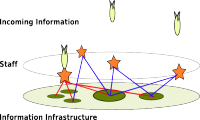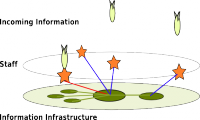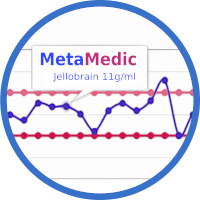If you are engaged with an organization, in all likelihood you use information systems every day.
Sometimes these systems are integrated to work well with one another, and often times they are not. Building coordinated systems requires intention and know how (and a little elbow grease).
Inefficient Model: isolated micro-systems

This diagram represents a typical organization.
Information comes into the system (the left-most torpedo) and a staff member usually has to enter information into: an emailing program like outlook, an excel spreadsheet, a central data repository like a database, and maybe an accounting software program (represented by the red lines).
When other staff members need to access different information, they also will need to look in several places (blue lines).
Efficient Model: integrated ecosystems

When information systems are integrated, the different systems speak with one another in a way that minimizes input of information by the person receiving it, and also the amount of places people have to look to get that information.
In this case the systems are doing the work so that your staff doesn't have to.
How jellobrain can help.
- Leverage, Integrate + Customize your existing information systems to better meet the needs of your organization.
- Identify + Strategize solutions that adequately meet your needs.
- Design, Implement + Configure custom data systems for your organization.
- Develop + Maximize Web Presence with platforms that enable you to easily update and add content to your site.
- Make the Computers do the busy work so that you don't have to.
Information Systems Audit
jellobrain has worked with dozens of small businesses and non-profit organizations to help streamline, manage and integrate their information systems.
The first step towards understanding the personalized benefit to your organization is to complete Information Audit for your business. Please click on the link above to understand more about what that entails. For more information, contact: ana(at)jellobrain.com

